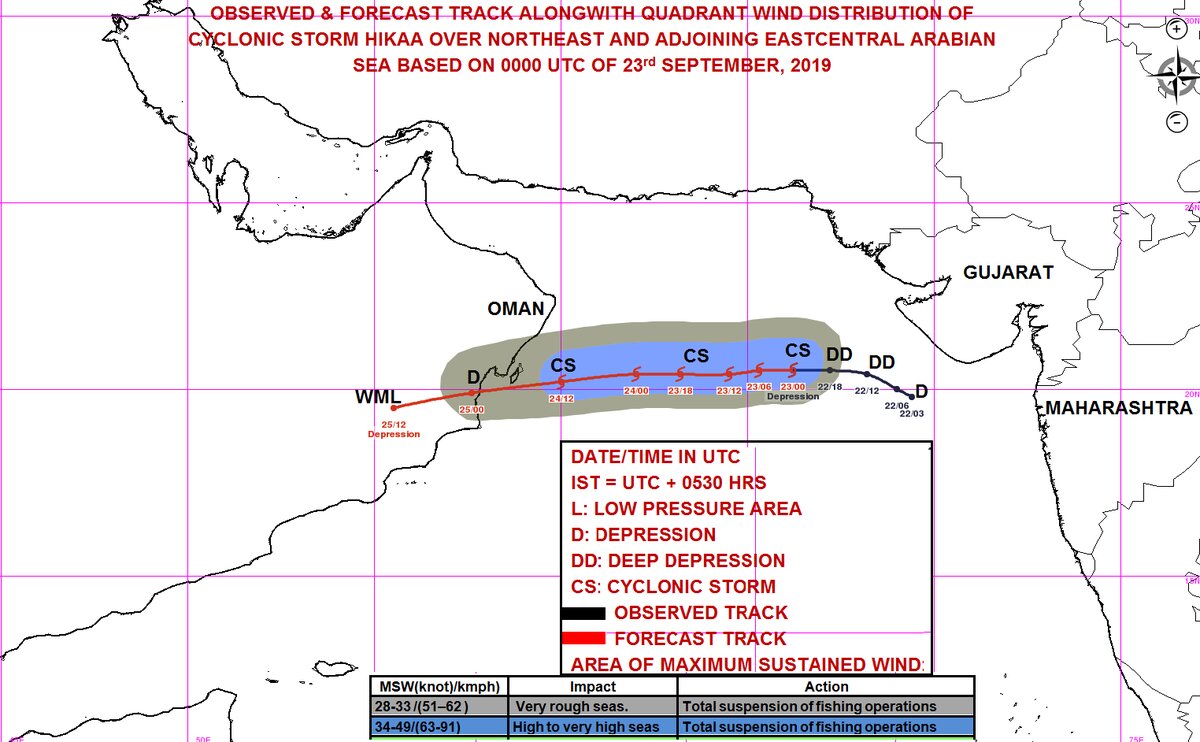Cyclonic Storm ‘HIKAA’ | 24 Sep 2019
A deep depression over the Arabian Sea has intensified into cyclonic storm ‘Hikaa’ that will cause strong winds along the Gujarat coast.
- The Cyclone is found over the region near about 490 km west-southwest of Veraval (Gujarat), 520 km south-southwest of Karachi (Pakistan) and 710 km east-southeast of Masirah (Oman).
- Hikka is likely to hit the Oman coast, south of Masirah, close to Duqm, which is a port and a refinery.
- The name Hikka has been given by the Maldives.
- Hikka is moving at a speed of 10 kmph packing wind speed of 90 kmph.
- The warm sea-surface temperatures of 29 to 30-degree celsius (the threshold limit is 27.5-degree celsius) will aid the convection (the process of cloud-building), favouring the system strength in the short term.
- But the prospect of penetration of dry air from the hot Arabian peninsula may act against the process of cloud building which might reduce the strength of the cyclone.
- India Meteorological Department has predicted 'Light to Moderate rainfall in many places' and 'Heavy Rainfall in isolated places' in coastal districts of Saurashtra and Kutch due to the possible formation of a deep depression over east-central and North-East the Arabian Sea off Gujarat coast.
- In coastal areas of Gujarat, the sea state expected to remain “rough to very rough” for the next few hours.
Arabian Sea Cyclones
- Cyclonic activity is comparatively less intense in the Arabian sea, as compared to the Bay of Bengal, where high-intensity severe cyclones originate frequently.
- In the last 120 years, just about 14% of all cyclonic storms, and 23% of severe cyclones, around India have occurred in the Arabian Sea.
- Arabian Sea cyclones are also relatively weak compared to those emerging in the Bay of Bengal.
- Gujarat coastline, where most of the cyclones emerging in the Arabian Sea are headed, is not very densely populated, ensures that the damage potential of the cyclones on the western coast is comparatively low.
Tropical Cyclone
- Cyclone is the formation of a very low-pressure system with very high-speed winds revolving around it. Factors like wind speed, wind direction, temperature and humidity contribute to the development of cyclones.
- Before cloud formation, water takes up heat from the atmosphere to change into a vapour. When water vapour changes back to liquid form as raindrops, this heat is released to the atmosphere.
- The heat released to the atmosphere warms the air around. The air tends to rise and causes a drop in pressure. More air rushes to the centre of the storm. This cycle is repeated.
- Since Hurricanes derive their energy from heated seawater which can be prevented by the presence of upper-level-winds that disrupt the storm circulation forcing it to lose its strength.

